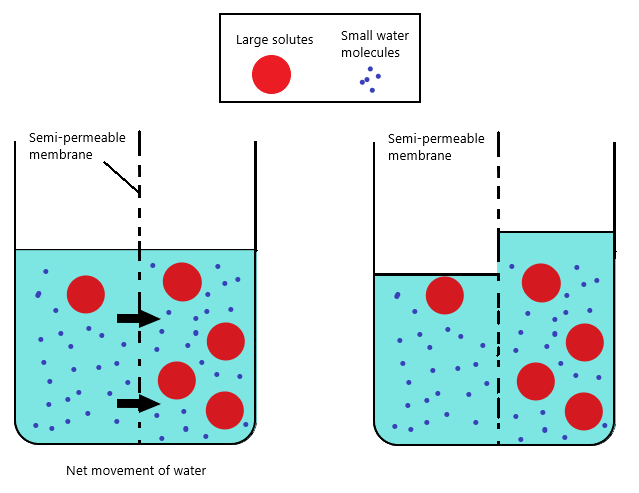Describe the Movement of Molecules in the Illustration.
C Molecules are moving from a higher concentration to a lower concentration and then from a lower to higher concentration. Movement of leukocytes along the endothelial surface which is due to weak alternate weak attachment and detachment to the endothelium.
In translational motion molecules move in certain directions.

. View the full answer. What will happen to these molecules over time. A Molecules are moving from a lower concentration to a higher concentration.
Explain why water moves this way 3 pts. The mechanism of stomata is mainly because of the response to the osmotic pressure of the guard cells in relation to the epidermal cells. Once equilibrium is reached in the apparatus shown in Figure 7-4 will the water molecules continue to.
If so describe this movement 3 pts. CMolecules are moving from a higher concentration to a lower concentration and then from a lower to higher concentration. Firm binding of leukocytes to the endothelium is called as adhesion.
Osmosis is a process which involves the solvent movement of a solvent water molecules across a semi-permeable membrane. The net movement of water molecules when cells are placed in a hypertonic solution depends in the concentration of dissolved solutions are greater outside of the cell. The liquid molecules stay towards the bottom but one or two do make it all the way to the top.
External environment ces Net movement is against concentration gradient. It can involve either the spreading of a material through a medium or the transport of a particle across a membrane. The direction of movement is from the high concentration of a solvent or low solute to low concentration of a solvent or high solute.
Simple diffusion is merely the movement of molecules along their concentration gradient without the direct involvement of any other molecules. Describe the movement of the D molecules on side A. Describe the net movement of water molecules when cells are placed in a hypotonic solution.
Describe how biogeochemical cycles provide organisms with the raw materials necessary to synthesize complex organic compounds. Factors effecting rate of diffusion. Movement of molecules from area of high concentration to areas of low concentration - a random movement.
They can show all the three types of molecular motion vibrational rotational and translational motion. Requires transport transport protein and energy input often from ATP. Water moves this way because it is seeking the greater concentration outside of the cell water molecules so it passes across the membrane into the solution with the higher concentration of solute.
When ready answer the following question. AMolecules are moving from a lower concentration to a higher concentration. The molecules and the chemical mediators involved are shown in the illustration below.
If so describe this movement 3 pts. Describe the particles molecules of a solid liquid and gas using an illustration. Involved in the movement of water molecules between the cell and cell organelles.
Describe the movement of molecules in the illustration. Movement of molecules from an area of higher concentration to an area of lower concentration. Some of the D molecules on side B will move to side A until there are equal amounts on both and equilibrium has been reached.
The intermolecular space between gaseous molecules is very large. The illustration indicates that the concentration of solute is higher on the outside of the cell than it is within the cell To move the solutes from the internal environment to the externa. Describe the movement of molecules in the illustration.
In vibrational motion molecules move back and forth whereas in rotational motion the molecule rotates in space. In plants it is involved in the movement of water molecules from the soil into the root nodules. Read through the information presented and be sure to click on Animate beneath the illustration.
_____ Procedure continued D. AMolecules are moving from a lower concentration to a higher concentrationBMolecules are moving from a higher concentration to a lower concentrationCMolecules are moving from a higher concentration to a lower concentration and then from a lower to higher concentrationDMolecules are moving from a. Types of passive transport no energy required diffusion.
The gas takes up quite a bit more space than the liquid and has molecules bouncing all over the container. Describe the movement of molecules in the illustration. A difference in the concentration of a substance across a distance.
Describe the net movement of water molecules when cells are placed in a hypotonic solution. Structure maintains integrity of the cell and controls the passage of materials into and out of the cell. Read through the information presented and be sure to click on Animate beneath the illustration.
All the examples given above were instances of simple diffusion. When ready answer the following question. Molecules or ions moving from regions of higher concentration towards regions of lower concentrationRequires no energy.
The cell organell that digests worn cellular parts or substances that enter cells. B Molecules are moving from a higher concentration to a lower concentration. The molecules in the gas are also moving faster than the molecules in the liquid phase.
Draw your illustration on the assigned object in each state of - 12596743. Describe the movement of the water molecules in the illustration above - 23442216 syeve5046 syeve5046 1 week ago Math Junior High School answered Describe the movement of the water molecules in the illustration above 1. BMolecules are moving from a higher concentration to a lower concentration.
Cite textual evidence from earlier chapter to support your response.


No comments for "Describe the Movement of Molecules in the Illustration."
Post a Comment